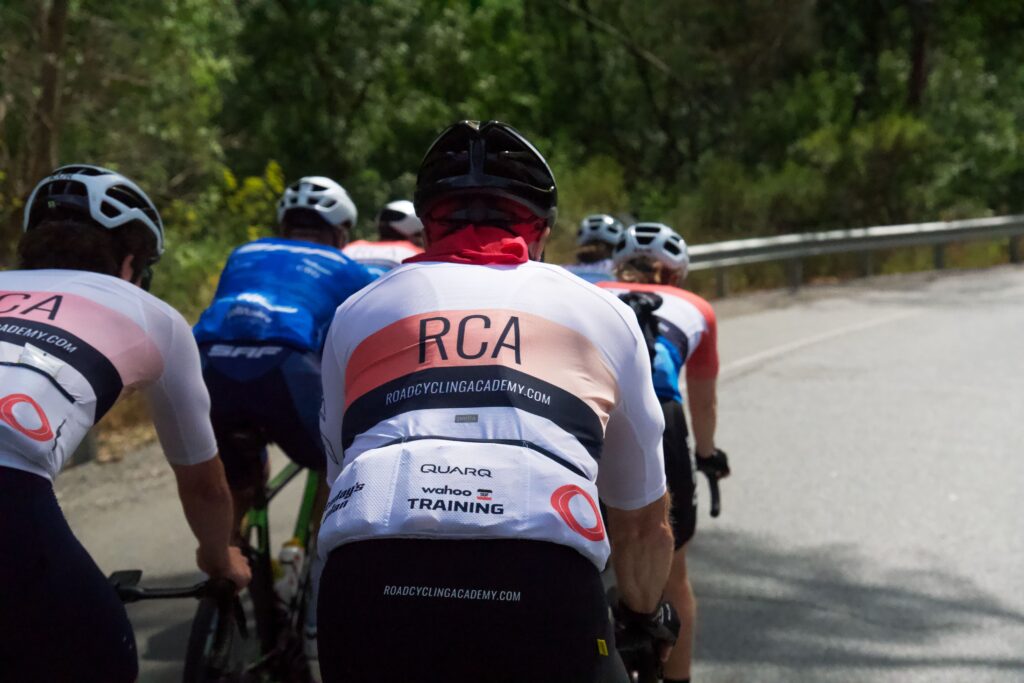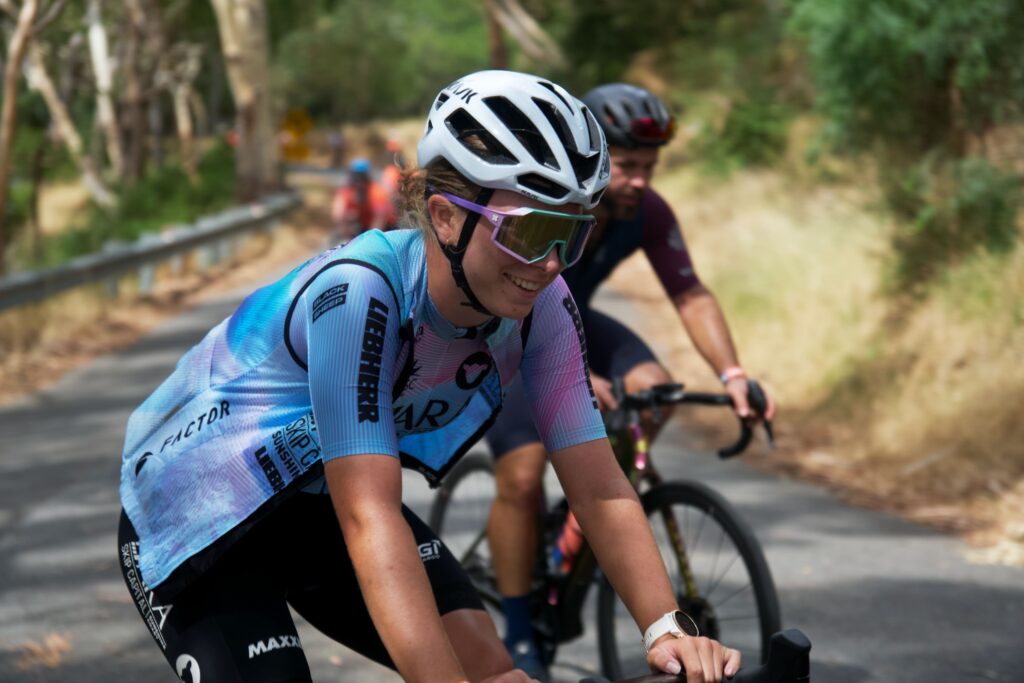Build cycling endurance and achieve your goals — it’s easier than you think.

If you have an event coming up and you need to build cycling endurance, we’ve got you covered.
We know how far away your goals may seem, especially if you’ve been off the bike for a while, or if you’re just starting out.
Even if you don’t have an event coming up, improving your cycling endurance will make you a better and stronger cyclist capable of riding further with less fatigue.
So, how do you build cycling endurance? It’s actually rather simple, and this blog post will detail every step.
Key takeaways:
- Perform the bulk of your training at zone 2 intensity
- Add interval training to your schedule (x1 a week minimum)
- Strive for consistency over everything — the more you ride, the better you’ll get
What is cycling endurance?

If you’ve spent any amount of time searching for how to increase cycling endurance, you’ll have encountered the phrase, VO2 Max. The concept may seem confusing at first, but all it is is a fancy phrase used to describe the maximal amount of oxygen your body can utilise when exercising [4].
Typically, the higher your VO2 Max, the longer you can ride with less fatigue.
And while other components affect cycling endurance — glycogen stores, your fuelling strategy, etc. — if you focus on improving your aerobic endurance and VO2 Max, you’ll become a better cyclist.
The 3x winner of the Tour de France, Greg LeMond, had a reported VO2 Max of 92.5ml/g/min. Lance Armstrong was 84/ml/kg/min, and Chris Froome was 88.2/ml/kg/min.
For us mere mortals, however, a VO2 Max (of 44 (males) and 39.5/ml/kg/min (females) is considered good for those aged between 30-39. Respective scores of 48.3 and 42.4 are regarded as excellent.
While improving aerobic cycling endurance should be your goal, anaerobic power is still an important determinant of cycling performance [6].
You can add short and explosive efforts to your rides and resistance training to improve muscular strength and anaerobic power [7]. That will make those short and punchy climbs easier.
“When your legs scream stop and your lungs are bursting, that’s when it starts. That’s the hurt locker. Winners love it there.” — Chris McCormack
How does a higher VO2 Max equal better endurance?
Regular aerobic training increases maximum lung capacity and efficiency. It also strengthens the heart — sending more blood to the working muscles and organs with less effort.
If you were wondering, that’s why many endurance athletes have low resting heart rates.
Training at a low intensity for long periods is a fantastic way to increase your VO2 Max — but we’ll cover this in more detail shortly.
Want to see how a VO2 Max test is performed? Watch Cam undergo a lactate threshold and VO2 Max test with Luke Mcllory from METS performance consulting.
“A bicycle ride around the world begins with a single pedal stroke” — Scot Stoll.
How to build cycling endurance – train the right way
Most riders, whether they’re a total beginner or more experienced roadie, can improve their cycling endurance and VO2 Max.
You need to build a bigger engine to ride further with less fatigue.
There are 2 main ways to build this engine to increase your VO2 Max and aerobic endurance:
- Zone 2 training
- High-intensity interval training (HIIT)
Zone 2 training to build cycling endurance
The bulk of your time spent in the saddle should be done at zone 2 intensity. Although, interval training definitely has its place in any plan.
Zone 2 training is often described as a difficulty where you can hold a conversation without gasping for air — it’s easy riding. And if you think you’re going too easy, chances are you’re doing it right.
Training in this aerobic development zone increases your lung capacity, the size and strength of your heart — mainly the left ventricle — and the cell’s total number of myoglobin and mitochondria [1,4]. The more mitochondria you have available, the more energy your cells can access [3].
Zone 2 training should be performed at 55% to 70% of your FTP or 60-70% of your maximum heart rate.
Aim to cycle at zone 2 for 90 minutes or longer. That includes those long weekend rides of 3, 5, or even 6 hours.
Related: Zone 2 Training for Cycling: How to Improve Your Aerobic Endurance.
High-intensity Interval training to improve cycling endurance and VO2 Max
High-intensity interval training, or HIIT for short, consists of short bouts of increased intensity followed by a period of rest.
You repeat anywhere from 2-5 repetitions — a good range to aim for as a beginner — and start with an easy effort to warm-up, and a gentle spin to cool down.
If you prefer to train indoors and have a smart trainer, you can use either ERG mode to set a specific power target for increased accuracy using a virtual training app such as Zwift.
You could even do a local bunch ride, pushing yourself to the limit. If the weather isn’t ideal for outdoor riding, virtual bunch rides and races are a good alternative to really push yourself and get those high-power improvements in a more interactive manner.
Unlike zone 2 training, interval training allows you to stress other zones, stimulating aerobic, anaerobic, and even musculoskeletal adaptations.
But just how effective is interval training for those looking to build cycling endurance?
One study took 8 untrained men (between the ages of 23-28 years old) and had them complete 5 weeks of HIIT.
Participants performed 5 weeks of VO2 Max interval training, with an average session consisting of 4-5 x 4-minute efforts at ≥ 90% max heart rate with 2-minute rest intervals between repetitions.
Results showed an increase in power output and a 14 and 17% improvement in VO2 Max [2].
A few tips for interval training success:
- Start with 1 session/week
- Gradually build up your fitness and increase the intensity incrementally
- Add 1 repetition at a time (and only when you feel like you can handle it)
- Don’t overcook it — leave 1 (ish) repetition on the road
- Do what you enjoy — you’ll be more likely to stick to it
- Strive for consistency; this is what produces results
“Go easy on the easy days and really smash it and save it for those hard days where there is a purpose with the intensity.” Medum Choe, Directeur Sportif Member
Join the next uplevel road cycling course
Whether you want to build cycling endurance for a specific event or if you just want to get fitter to ride longer with your mates, the uplevel road cycling course is for you.
You’ll perform sessions with riders just like you, prescribed by Road Cycling Academy coaches, consisting of everything from base training rides to interval training and hill repeats.
“My biggest learning from the RCA was the importance of zone 2 training. In my many years of competing professionally not once were we ever taught to ride slow! My training always consisted of riding all out everyday, week in, week out, for years. With RCA coach Ryan, we worked on a lot of Z2 training and in no time, I was winning races and was feeling the best I have ever felt!” Mary Dagget, Monthly Subscription Member
FAQs
What does endurance mean?
Endurance is about going long — doing something unpleasant for a long time. For example, the more cycling endurance you build, the further you can ride with less fatigue.
How can I cycle longer without getting tired?
Prioritise zone 2 training and time in the saddle. You can also sprinkle in high-intensity interval training to help build cycling endurance.
Does slow cycling increase stamina?
Cycling in zone 2 will improve endurance and stamina. You’ll also improve cardiovascular function, will stimulate musculoskeletal adaptations, and increase the total number of myoglobin and mitochondria in the cells.
References:
- Delgado, B.J. and Bajaj, T., 2019. Physiology, lung capacity.
- Hostrup, M., Lemminger, A.K., Stocks, B., Gonzalez-Franquesa, A., Larsen, J.K., Quesada, J.P., Thomassen, M., Weinert, B.T., Bangsbo, J. and Deshmukh, A.S., 2022. High-intensity interval training remodels the proteome and acetylome of human skeletal muscle. elife, 11, p.e69802.
- Kamga, C., Krishnamurthy, S. and Shiva, S., 2012. Myoglobin and mitochondria: a relationship bound by oxygen and nitric oxide. Nitric Oxide, 26(4), pp.251-258.
- Mahdiabadi, J., Gaeini, A.A., Kazemi, T. and Mahdiabadi, M.A., 2013. The effect of aerobic continuous and interval training on left ventricular structure and function in male non-athletes. Biology of sport, 30(3), pp.207-211.
- Marsh, A.P. and Martin, P.E., 1997. Effect of cycling experience, aerobic power, and power output on preferred and most economical cycling cadences. Medicine and Science in Sports and Exercise, 29(9), pp.1225-1232.
- Tanaka, H., Bassett Jr, D.R., Swensen, T.C. and Sampedro, R.M., 1993. Aerobic and anaerobic power characteristics of competitive cyclists in the United States Cycling Federation. International journal of sports medicine, 14(06), pp.334-338.
- Tanaka, H. and Swensen, T., 1998. Impact of resistance training on endurance performance: A new form of cross-training?. Sports medicine, 25, pp.191-200.

